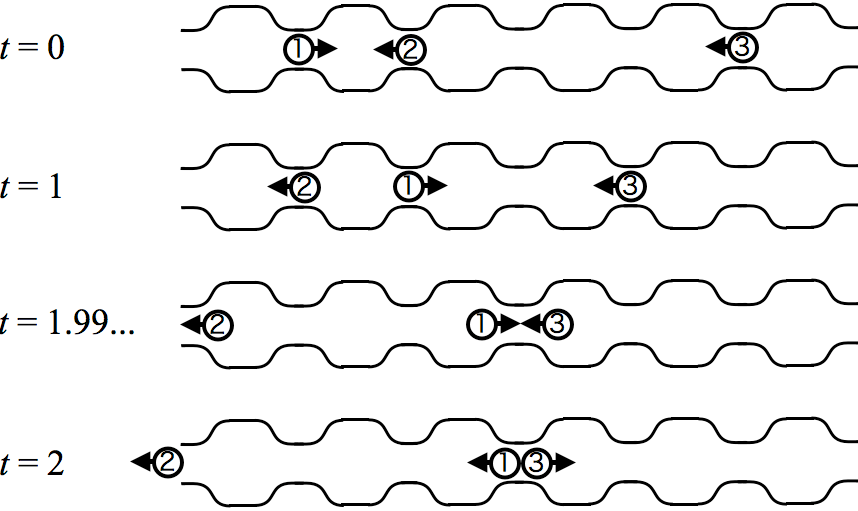The Last Ant(模拟)
来源:互联网 发布:怎样做app软件 编辑:程序博客网 时间:2024/05/29 06:47
题目链接:http://judge.u-aizu.ac.jp/onlinejudge/description.jsp?id=1336
Problem B: The Last Ant
A straight tunnel without branches is crowded with busy ants coming and going. Some ants walk left to right and others right to left. All ants walk at a constant speed of 1 cm/s. When two ants meet, they try to pass each other. However, some sections of the tunnel are narrow and two ants cannot pass each other. When two ants meet at a narrow section, they turn around and start walking in the opposite directions. When an ant reaches either end of the tunnel, it leaves the tunnel.
The tunnel has an integer length in centimeters. Every narrow section of the tunnel is integer centimeters distant from the both ends. Except for these sections, the tunnel is wide enough for ants to pass each other. All ants start walking at distinct narrow sections. No ants will newly enter the tunnel. Consequently, all the ants in the tunnel will eventually leave it. Your task is to write a program that tells which is the last ant to leave the tunnel and when it will.
Figure B.1 shows the movements of the ants during the first two seconds in a tunnel 6 centimeters long. Initially, three ants, numbered 1, 2, and 3, start walking at narrow sections, 1, 2, and 5 centimeters distant from the left end, respectively. After 0.5 seconds, the ants 1 and 2 meet at a wide section, and they pass each other. Two seconds after the start, the ants 1 and 3 meet at a narrow section, and they turn around.
Figure B.1 corresponds to the first dataset of the sample input.

Figure B.1. Movements of ants
Input
The input consists of one or more datasets. Each dataset is formatted as follows.
n ld1 p1d2 p2...dn pn
The first line of a dataset contains two integers separated by a space. n (1 ≤ n ≤ 20) represents the number of ants, and l (n + 1 ≤ l ≤ 100) represents the length of the tunnel in centimeters. The following n lines describe the initial states of ants. Each of the lines has two items, di and pi, separated by a space. Ants are given numbers 1 through n. The ant numbered i has the initial direction di and the initial position pi. The initial direction di (1 ≤ i ≤ n) is L (to the left) or R (to the right). The initial position pi (1 ≤ i ≤ n) is an integer specifying the distance from the left end of the tunnel in centimeters. Ants are listed in the left to right order, that is, 1 ≤ p1 < p2 < ... < pn ≤ l - 1.
The last dataset is followed by a line containing two zeros separated by a space.
Output
For each dataset, output how many seconds it will take before all the ants leave the tunnel, and which of the ants will be the last. The last ant is identified by its number. If two ants will leave at the same time, output the number indicating the ant that will leave through the left end of the tunnel.
Sample Input
3 6R 1L 2L 51 10R 12 10R 5L 72 10R 3L 82 99R 1L 984 10L 1R 2L 8R 96 10R 2R 3L 4R 6L 7L 80 0
Output for the Sample Input
5 19 17 18 298 28 28 3
#include<cstdio>#include<cstring>#include<cstdlib>#include<cmath>#include<string>#include<stack>#include<queue>#include<vector>#include<algorithm>#include<iostream>using namespace std;struct point{ int loc;//蚂蚁的坐标 int dir;//蚂蚁的方向}p[50];int n,len;int num[50];int t[50];//原本是写成time[50],我在AIZU上面交了几次,返回CE。后来才知道oj上面显示这个跟time.h头文件冲突(我又没写这个头文件.....有点不懂),之后改了过来int main(){ while(scanf("%d%d",&n,&len)&&n&&len)//n代表蚂蚁的数目,len代表木棍的长度 { for(int i=1;i<=n;i++) { getchar();//因为%c输入会吃掉回车符 char a; int b; scanf("%c %d",&a,&b); p[i].loc=b; if(a=='R') p[i].dir=1; else p[i].dir=0; if(p[i].dir)//根据白书上的思路,先把时间求出来 t[i]=len-p[i].loc; else t[i]=p[i].loc; } sort(t+1,t+1+n);//排序得到的t[n],就是最后一个蚂蚁出来的时间了 for(int i=1;i<=t[n];i++) { for(int j=1;j<=n;j++)//每一秒钟,更新一次蚂蚁的状态(坐标和方向) { if(p[j].dir) { p[j].loc++; } else { p[j].loc--; } } for(int j=1;j<n;j++)//这个处理要注意 { for(int k=j+1;k<=n;k++) { if(p[j].loc==p[k].loc)//判断如果有两只蚂蚁的位置一样,说明他们相撞了,那么就改变他们的方向 { p[j].dir=!p[j].dir; p[k].dir=!p[k].dir; } } } } int cnt=0;//判断是否最后有多个蚂蚁同时出来 for(int i=1;i<=n;i++) { if(p[i].loc==0||p[i].loc==len)//出来那么就代表他此时的位于木棍的左端或者右端(之前出来的蚂蚁此时坐标都是大于木棍的长度或者是小于零了) { num[cnt++]=i;//记录蚂蚁的编号 } } if(cnt==1) printf("%d %d\n",t[n],num[0]); else { for(int i=0;i<cnt;i++) { if(!p[num[i]].dir) { printf("%d %d\n",t[n],num[i]); break; } } } } return 0;}- The Last Ant(模拟)
- LA 6662 —— The Last Ant(模拟)
- UVA 6662 The Last Ant(模拟退火)
- UvaLive 6662 The Last Ant 模拟
- UVALive6662 The Last Ant
- the last ant
- Last mile of the way(NOIP2017模拟题)
- The Last Practice(HDU1405)
- hdu 1405 The Last Practice (数学)
- the last message
- Just The last
- The Last Night
- the last chance
- exception the last one.
- HDU1405:The Last Practice
- hdu_1405 The Last Practice
- HDU1405 The Last Practice
- hdu1405 The Last Practice
- codeforces 221B Little Elephant and Numbers
- poj 3320 Jessica's Reading Problem
- POJ 2029 Get Many PersimmonTrees(二维树状数组or递推)
- Eclipse在linux使用记录
- linux 的ulimit命令
- The Last Ant(模拟)
- 【Qt编程】Qt学习笔记<三>
- 第四周上机实践项目——程序的多文件组织
- Java 8 正式版发布
- 精美中文简历LaTex模板集锦
- 对Prim算法求最小生成树(MST)有深入的了解
- codeforces 221C Little Elephant and Problem
- 动态规划
- 嵌入式Linux之我行——Linux-2.6.30.4在2440上的移植之UDA1341声卡驱动


